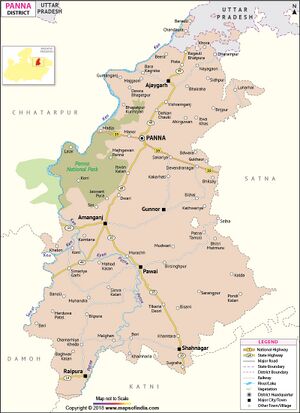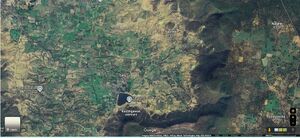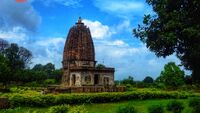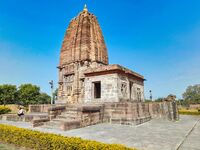Nachana Kuthara
| Author: Laxman Burdak IFS (R) |


Nachana Kuthara (नचना कुठारा) is a ruined historical site in Gunour Tehsil of Panna District of Madhya Pradesh, India. The site at present is represented by Kachhgawan village. Nachna-Kuthara are some of the earliest surviving stone temples. The temple site is near the Ganj village.
Variants
- Nachanakuthara (नचनाकुठारा) (म.प्र.) (AS, p.477)
- Nachna-Kuthara
- Nachana (नचना)
- Nachna (नचना)
- Kachhgawan (कछगवां) - Kachhgawan village is located in Gunnor tehsil of Panna district in Madhya Pradesh, India.
Location
Kachhgawan village is located in Gunnor tehsil of Panna district in Madhya Pradesh, India. Its Grampanchayat is Chhijoura Village, Code-459043, Village Population-0, Area in Hectares-133.53 hectares, Village Households-0. Gunnor is situated on the banks of Tons River, this river passes via Azamgarh before merging with Saryu River.[1]
Nachna-Kuthara temples
The temple site is near the Ganj village. It gets it name from the first publication in 1885 by Cunningham that brought it to the attention of western archaeologists during the British colonial era. Cunningham called it the Nachna-Kuthara temples in Volume 21 report of the Archaeological Survey of India, deriving it from the name of the district and another village in the region. The site is about 60 kms southwest of Satna, 100 kms southeast of Khajuraho, 100 kms north of Katni, and about 400 kms northeast of Bhopal. The nearest railway station is located in the city of Satna, while the closest major airport with daily services is Khajuraho.[2]
The site is deep inside a forest territory, at the entrance of a difficult to traverse valley within the Vindhya mountains. This, speculated Cunningham, may have contributed to the temple's survival during the Muslim invasion of this region.[3]
Jat Gotras Namesake
- Nachana (Jat clan) → Nachana Kuthara (नचना कुठारा) is a historical site in Gunour Tehsil of Panna District of Madhya Pradesh, India. Nachna-Kuthara are some of the earliest surviving stone temples. The temple site is near the Ganj village.
History
Nachna-Kuthara,[4][5] are some of the earliest surviving stone temples in central India along with those at Bhumara and Deogarh. Their dating is uncertain, but comparing their style to structures that can be dated, some of the Nachna temples are variously dated to the 5th or 6th century Gupta Empire era. The Chaturmukha temple is dated to the 9th-century.[4] These temples illustrate a North Indian style of Hindu temple architecture.[6][7]
Most of the temples in the area are in ruins. The best preserved and most studied monument is the Parvati temple at Nachna. The temples are built on a raised and moulded plinth, a square plan, a square sanctum that is surrounded by a circumambulation passage with perforated screen stone windows. The entrance into the sanctum is flanked by goddess Ganga and Yamuna. The Parvati temple has an upper storey with a doorway. The temple includes both religious motifs and secular scenes such as amorous mithuna couples.[8][9]The temples are notable for some of the earliest known stone friezes narrating several scenes from the Hindu epic Ramayana.[10][11][12]
The temples are near the Panna National Forest, are now a pilgrimage site, which is also referred to as Chaumukhnath.
Nearby Sites
Several smaller archaeological sites are found in a 15 km radius of Nachna: Pipariya, Khoh Satna, Bhumara, and others. These are also attributed to the Gupta period, but are much less known and explored. In 1979 the Shiva temple of Bhumara was restored; it is one of the best preserved. The Gupta Temple of Tigawa is located about 80 km south-west, with another Gupta temple in Sanchi. The ruins of Bharhut Buddhist stupas are 12 km east. Dashavatara Temple is in Deogarh.
नचना कुठारा
विजयेन्द्र कुमार माथुर[13] ने लिखा है....नचना कुठारा भूतपूर्व अजयगढ़ रियासत (मध्य प्रदेश) में भुमरा से 10 मील की दूरी पर स्थित है। यह अपने मंदिर के लिए विशिष्ट रूप से जाना जाता है। भुमरा तथा नचना कुठारा के मंदिर पूर्व गुप्त कालीन वास्तुकला का प्रतिनिधित्व करते हैं।[1]
मंदिर की वास्तुकला: जनरल कनिंघम ने यहाँ के मंदिर को देवी पार्वती का मंदिर बताया है। यह मंदिर पूर्व गुप्त कालीन जान पड़ता है। भुमरा के प्रसिद्ध मंदिर से इसका बहुत सादृश्य है। मंदिर का गर्भगृह 15½ फुट बाहर और 8 फुट अंदर से है। गर्भगृह के चारों ओर पटा हुआ प्रदक्षिणा मार्ग 33 फुट बाहर और 26 फुट अंदर से है। मंडप 26 फुट × 12 फुट है। नचना कुठारा के मंदिर की तक्षण कला भुमरा के शिल्प के समान ही सूक्ष्म और सुकुमार नहीं है। इसमें गर्भगृह के ऊपर एक कोष्ठ भी है, जो कि भुमरा में नहीं है। भुमरा तथा नचना कुठारा के मंदिर पूर्व गुप्त कालीन वास्तुकला का उदाहरण प्रस्तुत करते हैं।
चौमुखनाथ मंदिर

नचना हिंदू मंदिर, जिन्हें नचना-कुठारा में नाचना मंदिर या हिंदू मंदिर भी कहा जाता है,पन्ना जिले, मध्य प्रदेश, भारत में भुमरा और देवगढ़ के साथ मध्य भारत में सबसे पहले जीवित पत्थर के मंदिर हैं। उनकी डेटिंग अनिश्चित है, लेकिन उनकी शैली की तुलना उन संरचनाओं से की जा सकती है जिन्हें दिनांकित किया जा सकता है, कुछ नाचना मंदिर 5 वीं या 6 वीं शताब्दी के गुप्त साम्राज्य के युग के विभिन्न प्रकार के हैं। चतुर्मुख मंदिर 9वीं शताब्दी का है। ये मंदिर हिंदू मंदिर वास्तुकला की उत्तर भारतीय शैली को दर्शाते हैं।[14]
नचना - गुप्तों की छाप
Source - https://puratattva.in/nachna-imprints-of-the-guptas/
नचना/नचने: मध्य प्रदेश के पन्ना जिले में एक छोटा सा गांव है। इस जगह की प्राचीनता को सबसे पहले अलेक्जेंडर कनिंघम ने 1883-84 में गांव का दौरा करके उजागर किया था और आस-पास के गांवों के नाम जानने के बाद उन्होंने इस जगह का नाम नचना-कुठारा रखा।[15] हालांकि, अब इस गांव को कछगवान (कछगवां) के नाम से जाना जाता है और बगल के गांव को नचने (नाचने) के नाम से जाना जाता है। आरडी बनर्जी अगले विद्वान थे जिन्होंने 1919 में भारतीय पुरातत्व सर्वेक्षण, पश्चिमी सर्किल के अधीक्षक की हैसियत से मध्य भारत के अपने दौरे के दौरान इस जगह का दौरा किया था। ओसी गांगुली द्वारा एक चट्टान के आकार के गुप्तकालीन मंदिर के उल्लेख से उनकी रुचि जागृत हुई। जब उन्होंने दो ज्ञात मंदिरों की खोज की, तो इसके अलावा, उन्हें जंगल में चार और मंदिरों के अवशेष मिले। [16]
गांव का प्रारंभिक राजनीतिक इतिहास मध्य भारत के सामान्य इतिहास से लिया जा सकता है। यह क्षेत्र चौथी-पांचवीं शताब्दी ई. के दौरान वाकाटकों के अधीन रहा होगा। हालांकि , ऐसा प्रतीत होता है कि यह सीधे उनके द्वारा नहीं बल्कि उनके सामंतों, उच्चकल्पों द्वारा शासित था । गांव के तालाब में पाए गए एक शिलालेख, नचना-की-तलाई शिलालेख में एक निश्चित व्याघ्रराज का उल्लेख वाकाटक राजा पृथ्वीसेन द्वितीय (470-490 ई.) के अधीन एक सामंत के रूप में किया गया है।[17] डबरुइल का सुझाव है कि शिलालेख का व्याघ्रराज उसी नाम का उच्चकल्प राजकुमार हो सकता है जैसा कि खोह और करितालाई क्षेत्र के विभिन्न उच्चकल्प शिलालेखों में उल्लेख किया गया है। [18] उच्चकल्पों ने नचना से लगभग 50 किमी दूर स्थित अपनी राजधानी उंचेहारा से शासन किया। इसलिए, यह बहुत संभव है कि कछगाव (नचना-कुठारा) पर उच्चकल्पों का शासन था। यदि इसे स्वीकार किया जाता है तो यह कहा जा सकता है कि उच्चकल्पों की निष्ठा वाकाटकों से गुप्तों के शासन के बाद के काल में स्थानांतरित हो गई क्योंकि व्याघ्र के उत्तराधिकारियों ने अपने शिलालेखों की तिथि बताई जो आम तौर पर गुप्त युग का संदर्भ देती है। वास्तुकला की संपदा को ध्यान में रखते हुए, जोआना विलियम्स का सुझाव है कि गांव ने एक सांस्कृतिक और व्यापार केंद्र के रूप में एक महत्वपूर्ण स्थान रखा होगा, और शायद यह उच्चकल्पों की राजधानी थी। [19]
गुप्त और बाद के गुप्त काल के कला प्रदर्शनों की सूची में नचना का बहुत महत्वपूर्ण स्थान है। विलियम्स का मानना है, " नचना शैली का एक पहलू जो कार्यशाला परंपराओं में एक साधारण निरंतरता से परे चला गया, वह विषय वस्तु का आविष्कारशील उपचार है। इसका तात्पर्य एक ओर कारीगरों की परिष्कृत मार्गदर्शन के प्रति ग्रहणशीलता और दूसरी ओर जीवंत स्थानीय बुद्धिजीवियों से है। यह तत्वों का यह संयोजन है, छोटे रूपांकनों से लेकर सामान्य सौंदर्य तक, जो एक प्रतिष्ठित विरासत से प्राप्त हुआ है और फिर भी नए तरीकों से विकसित हो रहा है, जो नचना के अवशेषों को गुप्त कला का एक जोरदार समापन बनाता है। (sic)" [20]
पार्वती मंदिर - मंदिर पश्चिम की ओर है और शिव को समर्पित है। कनिंघम ने इसका नाम पार्वती मंदिर रखा क्योंकि पास में ही शिव को समर्पित एक बड़ा मंदिर था, इसलिए उन्होंने माना होगा कि यह छोटा मंदिर पार्वती के लिए हो सकता है। यह एक ऊंचे चबूतरे पर बना है और इसमें एक गर्भगृह और एक प्रदक्षिणा-पथ (परिक्रमा पथ) है। चूंकि मंदिर में प्रदक्षिणा -पथ था , इसलिए यह इस विशेषता वाला सबसे पुराना जीवित मंदिर है और इस प्रकार मंदिरों की संधार श्रेणी में आता है। गर्भगृह 8 फीट 10 इंच का एक वर्गाकार है और इसके चारों ओर 5 फीट चौड़ा बरामदा है जो एक दक्षिणा-पथ बनाता है, जिसे कभी छत से ढका जाता था। [21] बनर्जी ने उल्लेख किया है कि एकमात्र प्रवेश द्वार के सामने एक बरामदा था, जो अब पूरी तरह से ढह गया है। [22] उन्होंने आगे बताया कि मंदिर की बाहरी दीवारें, जो अब मंदिर की नींव के रूप में बची हुई हैं, पूरी लंबाई में गुफाओं, गुफाओं और आलों के साथ चट्टानों को दर्शाने के लिए उकेरी गई थीं। इन गुफाओं में गण (बौने), सिंह, यख , योद्धा, सूअर, मोर, बंदर, हिरण और महिलाएं स्थित थीं। मीस्टर बताते हैं कि हिंदू मंदिर वास्तुकारों के दिमाग में प्रमुख रूपक मंदिर के मुख्य भाग को पर्वत और गर्भगृह को गुफा के रूप में दिखाने का था और यह मंदिर शैली और डिजाइन की दुर्लभ श्रेणी में आता है जो केंद्र में गर्भगृह के साथ पहाड़ी वातावरण का अनुकरण करता है। [23] जहां प्लिंथ दीवार का हिस्सा अधिष्ठान ( वेदीबंध ) तक तैयार चिनाई का उपयोग करके बनाया गया है, वहीं इसके ऊपर का भाग अनियमित आकार के पत्थरों का उपयोग करके बनाया गया है जो प्राकृतिक चट्टान संरचनाओं के समान दिखते हैं। इन गुहाओं में लगे कई पैनल तुलसी संग्रहालय, रामबन (सतना) में हटा दिए गए हैं पर्वतीय क्षेत्र का समांतर समकालीन प्रतिनिधित्व 4 वीं -6 वीं शताब्दी ई. के कृष्ण-गोवर्धनधारी पैनल में मिलता है, जो अब भारत कला भवन, वाराणसी में है। इसकी स्थापत्य शैली और मूर्तिकला के तुलनात्मक विश्लेषण के आधार पर, मंदिर को 5 वीं शताब्दी ई. की अंतिम तिमाही का माना गया है , विलियम्स ने इसे 480-500 ई. के बीच वर्गीकृत किया है। [24]
इस सपाट छत वाले मंदिर का गर्भगृह दो मंजिला संरचना है। भूतल के नियमित वर्गाकार गर्भगृह के ऊपर एक अतिरिक्त कक्ष बनाया गया है । चूंकि इस ऊपरी कक्ष में चढ़ने के लिए कोई साधन प्रदान नहीं किया गया था, इसलिए, यह केवल एक सजावट का तत्व था या इसका कोई धार्मिक उद्देश्य था, यह निश्चित नहीं है। ऊपरी मंजिल अब अपने न्यूनतम अवशेषों के साथ बची है, बनर्जी की यात्रा के दौरान, वह बताते हैं कि ऊपरी कक्ष के केंद्र में एक छोटी सी सपाट छत को थोड़ा ऊपर उठाया गया था, और इसकी छत की स्लैब पास में खड़े एक बड़े पेड़ के कारण हिल रही थी। इसमें दो चैत्य के आकार की खिड़कियां थीं। [25] भूतल पर गर्भगृह की दीवारें सादी हैं और हर दीवार पर खिड़कियां हैं। वर्तमान मंदिर मूल के समान सजावट की भव्यता को प्रतिबिंबित नहीं करता है। कनिंघम से पीछे की खिड़की का विवरण लेते हुए, यह खिड़की अब मैदान में पास में पड़ी है पार्श्व दीवारों में खिड़कियाँ, खिड़कियाँ व्यालों से बनी थीं जिनमें केंद्रीय स्तंभ के दोनों ओर सवार खड़े थे, इन खिड़कियों को 1918 के बाद कभी भी चौमुखनाथ मंदिर के मंडप में लगाया गया था। गणों की छवियों को पार्श्व दीवारों में इनसेट किया गया था जैसा कि 1918 की तस्वीरों में देखा जा सकता है, हालाँकि, ये गण पैनल अब उपलब्ध नहीं हैं या खो गए हैं। मंदिर को सुशोभित करने वाले वर्तमान खिड़की के फ्रेम में नीचे की ओर आले हैं जिनमें विभिन्न मुद्राओं में गण रखे हुए हैं। गणेश की एक महत्वपूर्ण दो भुजाओं वाली छवि ऐसी ही एक खिड़की के केंद्र में पाई जाती है, उन्हें उनके गणपति कद का सुझाव देते हुए बीच के आले में रखा गया है। गर्भगृह का द्वार चार शाखाओं (बैंड) से बना है। गंगा और यमुना द्वार - जाम के आधार पर मौजूद हैं। नागों की आकृति वाली दो खिड़कियाँ, जो कभी मंदिर की सामने की दीवारों में लगी हुई थीं, अब पास के चतुर्मुख महादेव मंदिर के गर्भगृह द्वार के दोनों ओर लगी हुई हैं।
मंदिर में कुछ शुरुआती पाषाण रामायण पैनल थे, जिनकी कुल संख्या छह थी। बचे हुए पैनलों में, राम के वनवास, रावण द्वारा सीता के अपहरण की कहानी दर्शाई गई है, और अंतिम पैनल में हनुमान को रावण के दरबार में लाया जाता हुआ दिखाया गया है। अनुक्रम में पहला पैनल सीता के लक्ष्मण के साथ संवाद के दृश्य को दर्शाता है, जब राम स्वर्ण मृग के लिए चले गए थे। जब स्वर्ण मृग, राम का रूप धारण करके मदद के लिए पुकारा, तो लक्ष्मण सीता को छोड़कर राम की खोज में जाने के लिए तैयार नहीं थे। अपने कानों पर हाथ रखे बीच की पुरुष आकृति लक्ष्मण को दर्शाती है, जब सीता ने अपने भाई की मदद न करने के लिए उसे डांटा था, तब उसने अपने कान बंद कर लिए थे। बाहर जाने की मुद्रा में दिखाई गई सबसे दाईं ओर की पुरुष आकृति, फिर से लक्ष्मण है, जो अनिच्छा से सीता को छोड़कर राम की खोज में चले गए थे। अगले पैनल में रावण को सीता से भिक्षा लेते हुए दिखाया गया है और यह अपनी उत्कृष्ट शैली और डिजाइन के लिए बहुत महत्वपूर्ण है। अगले तीन पैनल हनुमान की राम और लक्ष्मण से मुलाकात से संबंधित हैं, जिसके बाद सुग्रीव और बाली के बीच द्वंद्वयुद्ध होता है। एक द्वंद्व पैनल में, सुग्रीव और बाली दोनों ही पहचान में नहीं आ रहे हैं, हालांकि अगले पैनल में सुग्रीव ने एक लंबी माला पहनी हुई है जिससे राम उसे पहचान सकते हैं जबकि सुग्रीव अपना तीर खींच लेता है। आखिरी पैनल में हनुमान को बांधकर रावण के दरबार में लाया गया है। इन पैनलों के आयामों पर ध्यान देते हुए, विलियम्स [26] ने बताया कि ये पैनल शायद पार्वती मंदिर के चट्टानी आकार के आधार से नहीं आए हैं और इनकी तिथि 500-510 ई. है, जबकि सीमा बावा [27] का मानना है कि ये किसी खोए हुए वैष्णव मंदिर का हिस्सा थे।
रामायण के इन पैनलों के अलावा, आस-पास कई मूर्तियाँ पाई गईं और उन्हें साइट पर और मंदिर परिसर के आसपास मूर्तिकला शेड में एकत्र किया गया। इनमें से एक चतुर्मुख-लिंग है जो लखोरोबाग के पास पाया गया था और 1965 और 1969 के बीच किसी समय मंदिर परिसर में लाया गया था। [28] यह सुझाव दिया जाता है कि इस प्रकार का लिंग पार्वती मंदिर में पूजा की मुख्य वस्तु हो सकती है। राहु के साथ सात ग्रहों को दिखाने वाली एक फ्रिज़ अष्ट-ग्रहों (आठ ग्रहों) के सबसे पुराने जीवित उदाहरणों में से एक है। यह वह समय था जब केतु को अभी तक ग्रहों में नहीं माना जाता था। यह फ्रिज़ अब साइट पर उपलब्ध नहीं है और 1965 और 1967 के बीच किसी समय खो गई थी। [29]
चतुर्मुख महादेव (चौमुखनाथ) मंदिर –

यह पूर्वमुखी मंदिर वर्तमान में पूजा के लिए है। पार्वती मंदिर की तरह यह मंदिर भी एक जगती (चबूतरे) पर बना है। यह एक गर्भगृह , एक अंतराल और एक आधुनिक मंडप से बना है । मंदिर के आधुनिक मंडप का पुनर्निर्माण 1918 में पास के पार्वती मंदिर से सजावटी सामग्री का उपयोग करके किया गया है। निर्माण तकनीक और उपयोग की गई सामग्री से यह बहुत स्पष्ट है कि वर्तमान संरचना समरूप नहीं है बल्कि विभिन्न युगों, कम से कम दो अलग-अलग अवधियों से आने वाली सामग्रियों से बनी है। आरडी त्रिवेदी ने सही कहा है कि मंदिर के निर्माण के समय, भद्र -आला और अगल- बगल के खंभों वाले द्वार के निर्माण में पहले की अवधि की स्थापत्य सामग्री का उपयोग किया गया था ।[30] मंदिर अपने जंघा तक त्रि-रथ योजना में है,
बनर्जी ने उल्लेख किया है कि मंदिर के भद्र-आलों में पहले विष्णु, शिव और दुर्गा की प्रतिमाएं थीं। हालांकि, इस मंदिर के पुनर्निर्माण के दौरान, इन प्रतिमाओं को हटा दिया गया था और भद्र-आलों में छिद्रित खिड़कियां लगाई गई थीं, जिनमें दो बैंड तीन स्थान बनाते थे। ये खिड़कियां मूल रूप से एक पुराने मंदिर का हिस्सा थीं, जिसे इस नए ढांचे द्वारा प्रतिस्थापित किया गया था। खिड़कियों में बैंड के निचले हिस्से में, पाँच पैनल हैं, जिनमें अंदर गणों की छवियां हैं। गणों को एक चंचल मूड और विभिन्न मुद्राओं में दर्शाया गया है। पश्चिम की खिड़की में गणों की आकृतियाँ नहीं हैं , लेकिन एक रत्न डिजाइन है। खिड़कियों के ऊपर दो आले हैं, जो भित्तिचित्रों द्वारा अलग किए गए हैं। इन सभी आलों में विद्याधर जोड़े, उड़ते या खड़े दिखाई देते हैं। शैली और डिजाइन से, ये खिड़कियाँ पार्वती मंदिर का हिस्सा लगती हैं। कर्ण -आलों (कोने के आलों) में अष्ट-दिक्पाल थे , हालाँकि, केवल दो ही बचे हैं, दक्षिण में अग्नि और उत्तर में कुबेर।
गर्भगृह का द्वार शैली और निष्पादन में पार्वती मंदिर के समान है। लिंटेल गायब है और विलियम्स का उल्लेख है कि लिंटेल का एक टूटा हुआ टुकड़ा देखभाल करने वाले की झोपड़ी में लगा हुआ था। १७ लिंटेल पर शिव की एक छवि ललता-बिंब में अंकित है। विलियम्स ने दरवाजे की चौखट की तिथि ४९५-५०५ ई. बताई है और यह स्पष्ट है कि ९वीं शताब्दी ई. में पुनर्निर्मित यह मंदिर पांचवीं शताब्दी के गुप्त काल के मंदिर की जगह बनाया गया था। मंदिर का नाम भव्य चतुर्मुखी-शिवलिंग (चार मुख वाला लिंग) से लिया गया है। प्रवेश द्वार, या पूर्व की ओर वाला मुख शिव के तत्पुरुष पहलू का प्रतिनिधित्व करता है, जबकि दक्षिण की ओर वाला मुख अघोरा का प्रतिनिधित्व करता है, पश्चिम की ओर वाला मुख सद्योजात का प्रतिनिधित्व करता है, और उत्तर की ओर वाला मुख वामदेव पहलू का प्रतिनिधित्व करता है। शिव के भयानक पहलू का प्रतिनिधित्व करने वाला अघोरा चेहरा उभरी हुई आंखों, चौड़े खुले पर्वत और उभरे हुए दांतों के साथ खूबसूरती से उकेरा गया है।
शिलालेख: गांव और इसके निकटवर्ती गंज गांव में दो महत्वपूर्ण शिलालेख पाए गए हैं।
नचने की तलाई शिलालेख [31] - दिनांकित नहीं, वाकाटक राजा पृथ्वीविषेण द्वितीय (४६०-४८० ई.) के शासन को संदर्भित करता है - भाषा संस्कृत, मध्य भारत की वर्णमाला का बॉक्स-हेडेड प्रकार - इसे अलेक्जेंडर कनिंघम ने १८८३-८४ की अपनी यात्रा के दौरान नचना गांव के तालाब में खोजा था - इसमें लिखा है, व्याघ्रदेव, जो वाकाटक के महाराजा, प्रख्यात पृथ्वीविषेण के चरणों का ध्यान करते हैं, ने अपने माता-पिता के धार्मिक गुणों के लिए इसे बनाया है।
गंज वाकाटक शिलालेख [32] - भाषा संस्कृत, बॉक्स-हेडेड दक्षिणी किस्म के अक्षर - इस शिलालेख की खोज आरडी बनर्जी ने १९१९ में की थी - में लिखा है, व्याघ्रदेव, जो वाकाटक के (परिवार के) महाराजा प्रख्यात पृथ्वीविषेण के चरणों का ध्यान करते हैं, ने (अपने) माता-पिता के धार्मिक गुणों के लिए (इसे) बनाया है।
External links
https://en.wikipedia.org/wiki/List_of_Monuments_of_National_Importance_in_Madhya_Pradesh/West
See also
References
- ↑ https://www.pannalive.com/villages/gunnor/kachhgawan.php
- ↑ Swati Mitra. Temples of Madhya Pradesh. Goodearth. pp. 40–41. ISBN 978-93-80262-49-9.
- ↑ Cunningham, Bundelkhand and Rewa, ASI Report Vol. 21, pages 95-99
- ↑ Hardy, Adam (2014). "Nagara Temple Forms: Reconstructing Lost Origins". Journal of History and Social Sciences. 5. ISSN 2229-5798
- ↑ Paul Nietupski; Joan O'Mara (2011). Reading Asian Art and Artifacts: Windows to Asia on American College Campuses. Lehigh University Press. p. 52. ISBN 978-1-61146-072-8.
- ↑ Radhakumud Mookerji (1959). The Gupta Empire. Motilal Banarsidass. p. 146. ISBN 978-81-208-0440-1.
- ↑ George Michell (1977). The Hindu Temple: An Introduction to Its Meaning and Forms. University of Chicago Press. pp. 95–96. ISBN 978-0-226-53230-1.
- ↑ George Michell (1977). The Hindu Temple: An Introduction to Its Meaning and Forms. University of Chicago Press. pp. 95–96. ISBN 978-0-226-53230-1.
- ↑ Ulrich Wiesner (1978). Nepalese Temple Architecture: Its Characteristics and Its Relations to Indian Development. BRILL. pp. 45–51. ISBN 90-04-05666-1.
- ↑ B.C. Shukla (1990), The Earliest Inscription of Rama-Worship, Proceedings of the Indian History Congress, Vol. 51, pp. 838-841
- ↑ B.C. Shukla (1990), The Earliest Inscription of Rama-Worship, Proceedings of the Indian History Congress, Vol. 51, pp. 838-841
- ↑ Mandakranta Bose (2004). The Ramayana Revisited. Oxford University Press. pp. 337, 355. ISBN 978-0-19-516832-7.
- ↑ Aitihasik Sthanavali by Vijayendra Kumar Mathur, p.477
- ↑ चौमुखनाथ मंदिर
- ↑ कनिंघम, अलेक्जेंडर (1885)। 1883-84 में बुंदेलखंड और रीवा में एक दौरे की रिपोर्ट और 1884-85 में रीवा, बुंदेलखंड, मालवा और ग्वालियर में एक दौरे की रिपोर्ट। खंड XXI । भारतीय पुरातत्व सर्वेक्षण। नई दिल्ली। पीपी। 95-99
- ↑ 31 मार्च, 1919 को समाप्त वर्ष के लिए भारतीय पुरातत्व सर्वेक्षण, पश्चिमी सर्कल की प्रगति रिपोर्ट । पीपी। 60-61
- ↑ कॉर्पस इंस्क्रिप्शनम इंडिकेरम, खंड III, पीपी। 233-35
- ↑ डबरुइल, जी जौवो (1926)। व्याघ्र , भारतीय पुरातनपंथी खंड में प्रकाशित उच्चकल्प। एलवी। पी। 103
- ↑ विलियम्स, जोआना गॉटफ्रीड (1982) आईएसबीएन ०६९१०३९८८७. पृ. १०५
- ↑ विलियम्स, जोआना गॉटफ्रीड (१९८२)। गुप्त भारत की कला: साम्राज्य और प्रांत । प्रिंसटन यूनिवर्सिटी प्रेस। न्यू जर्सी। आईएसबीएन ०६९१०३९८८७. पृ. ११४
- ↑ ईआईटीए पृ. ३९
- ↑ ३१ मार्च, १९१९ को समाप्त वर्ष के लिए भारतीय पुरातत्व सर्वेक्षण, पश्चिमी सर्किल की प्रगति रिपोर्ट। पृ . ६१
- ↑ मिस्टर, माइकल डब्ल्यू. (१९८६)। एक प्रतीकात्मक वास्तुकला के लिए एक आकृति विज्ञान के विकास पर: भारत आरईएस में प्रकाशित: नृविज्ञान और सौंदर्यशास्त्र सं. १२. पृ. ३५
- ↑ विलियम्स, जोआना गॉटफ्रीड (१९८२)। गुप्त भारत की कला: साम्राज्य और प्रांत । प्रिंसटन यूनिवर्सिटी प्रेस। न्यू जर्सी। आईएसबीएन ०६९१०३९८८७. पृ. ११०
- ↑ ३१ मार्च, १९१९ को समाप्त वर्ष के लिए भारतीय पुरातत्व सर्वेक्षण, पश्चिमी सर्किल की प्रगति रिपोर्ट । पृ . ६१
- ↑ विलियम्स, जोआना गॉटफ्राइड (1982)। गुप्त भारत की कला: साम्राज्य और प्रांत । प्रिंसटन यूनिवर्सिटी प्रेस। न्यू जर्सी। आईएसबीएन 0691039887. पृ. ११
- ↑ बावा, सीमा (2018)। रामायण की कल्पना: प्रारंभिक कथात्मक मूर्तियों में शक्ति, मोचन और भावना भारतीय ऐतिहासिक समीक्षा खंड 45 में प्रकाशित। पृ. ९६
- ↑ विलियम्स , जोआना गॉटफ्राइड (1982)। गुप्त भारत की कला: साम्राज्य और प्रांत । प्रिंसटन यूनिवर्सिटी प्रेस। न्यू जर्सी। आईएसबीएन 0691039887. पृ. ११२
- ↑ १४ विलियम्स , जोआना गॉटफ्राइड (1982)। गुप्त भारत की कला: साम्राज्य और प्रांत । प्रिंसटन यूनिवर्सिटी प्रेस। न्यू जर्सी। आईएसबीएन 0691039887. पृ. 113
- ↑ त्रिवेदी, आर.डी. (1990). मध्य भारत में पर्तिहार काल के मंदिर . भारतीय पुरातत्व सर्वेक्षण. नई दिल्ली. पृ. 127
- ↑ कॉर्पस इंस्क्रिप्शनम इंडिकारम, खंड। तृतीय. पीपी. 233-35
- ↑ एपिग्राफिया इंडिका खंड। XVII. पृ. 12-14

